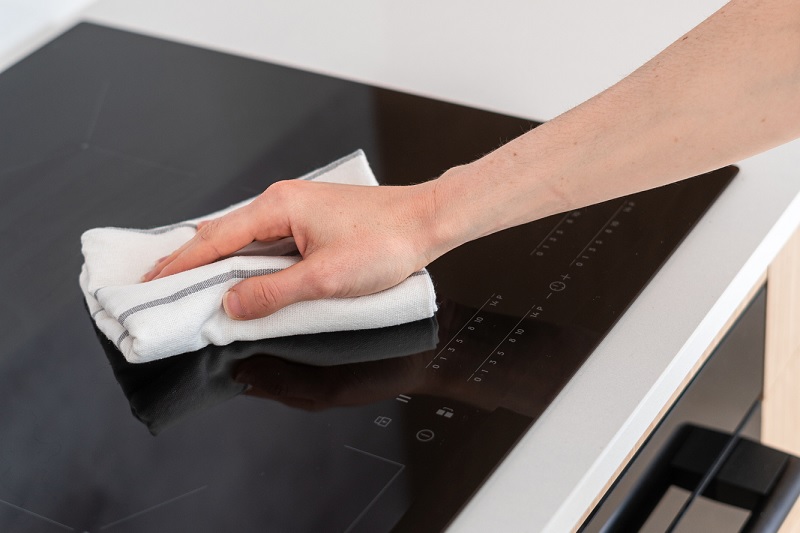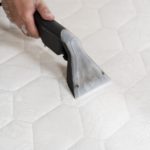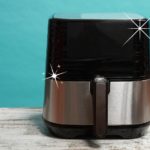Induction hobs are a popular choice for many kitchens due to their sleek design and energy-efficient cooking. But as with many kitchen appliances, they can quickly become dirty.
Keeping up with their general maintenance to ensure they run efficiently and provide a safe cooking environment.
If you’re wondering how to keep your induction hob looking clean and shiny, you’re not alone. And here we have the answers.
In this article, you will learn how to clean an induction hob quickly and efficiently.
We will provide clear instructions for using natural and store-bought cleaners and give you some top tips on caring for your hob between deep cleans.
What’s the Best Way to Clean an Induction Hob?
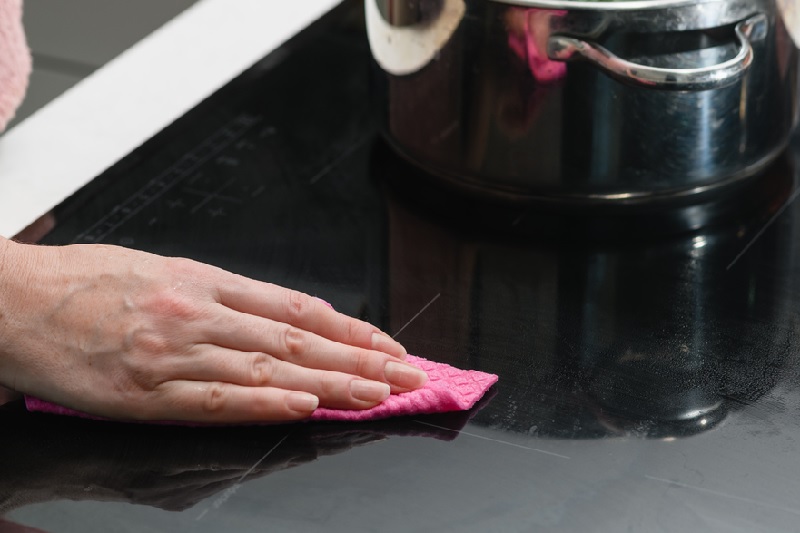
When it comes to a quick daily clean, the best way to clean an induction hob is by wiping the surface with a soft cloth and hot, soapy water after every use.
This will remove any build-up that has accumulated during cooking and will help you go longer between deep cleans (see below).
Thankfully, the design of induction hobs makes daily cleaning even more straightforward.
They usually lack traditional knob dials that can be challenging to clean, and properly installed hobs will be perfectly flushed with your kitchen worktop.
This means you shouldn’t need to get into hard-to-reach crevices to remove grease, dirt, and food particles—a quick wipe will do the trick.
How Do You Get Stubborn Stains Out of an Induction Hob?
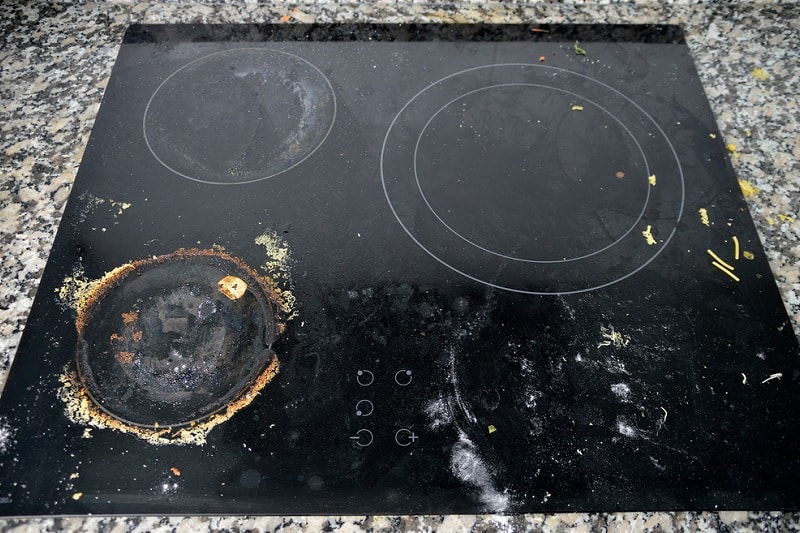
Despite your efforts to keep your induction hob clean, it might become stained and burned with persistent use.
In these cases, a wipe with soapy water will not suffice—you need a deeper clean to lift the stubborn pieces of grime and grease.
To achieve this deeper clean, many people opt for a harsh and abrasive cleaner. However, this will quickly cause the surface to become scratched and scuffed, making it look worse!
When this occurs, small pieces of food can become lodged in the scratches and will cause damage to the glass when a hot pan is placed on top.
To avoid this, the cleaning products and equipment you use on your induction hob must be as gentle and non-abrasive as possible.
The only exception is if the build-up has been left to sit for a long time. In this case, you must use a slightly stronger cleaner to break through the dirt and grime.
Depending on your preference, this can be done using natural ingredients or a specialist cleaner.
How to Clean an Induction Hob Using Natural Ingredients
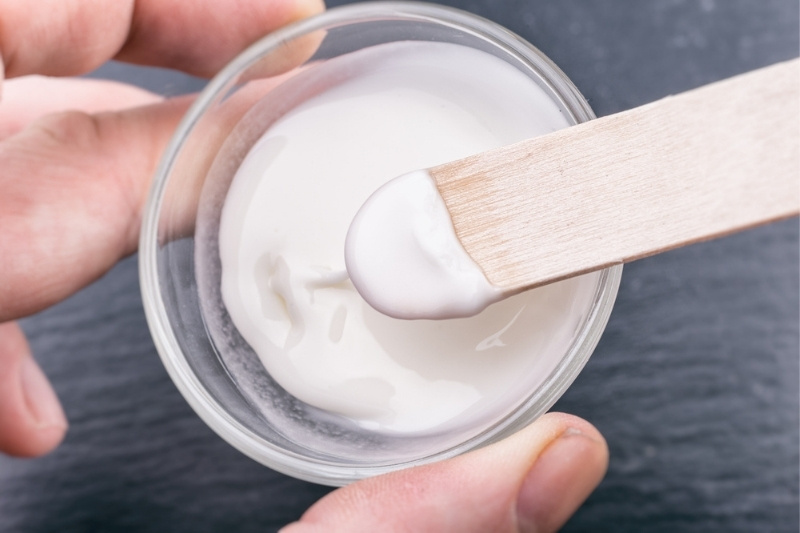
If you would rather avoid using chemical cleaners on your induction hob, you’re best option is to use natural ingredients when cleaning the glass.
White vinegar and bicarbonate of soda are two of the most powerful natural cleaners and will give you highly effective results when used as directed below:
- Use a paper towel to wipe any surface-level dirt and grime from the induction hob. This leaves the more stubborn pieces of food or stains that need cleaning more thoroughly.
- Prepare your cleaner by mixing together one part bicarbonate of soda and one part white vinegar to create a cleaning paste.
- Apply an even layer of the paste to your hob.
- Allow the cleaning paste to sit for 45 minutes so that it can effectively work into the stains, lifting the stuck-on dirt off of the glass of your induction hob.
- Dip a microfibre cloth in a solution of warm water and washing up liquid. Use the damp cloth to wipe away the cleaning paste and residual build-up from the induction hob.
- Dry the glass surface using a paper towel and reexamine your hob. If some dirt or stains remain, repeat steps 3 to 7 as necessary until the hob is completely clean.
- Buff the glass surface using a clean and dry microfibre cloth to remove smears and leave the hob looking smooth and shiny.

How to Clean an Induction Hob Using Specialist Cleaners
When using a store-bought cleaner, try to find one that has been specially formulated for use on induction hobs.
Those with a creamy, non-scratch formula will be best, as they can remove any stains or burnt-on residue from your hob without causing any damage to the glass surface.
HG Extra Strong Hob Cleaner is ideal for this purpose, although there are many other brands out there that you can also try.
The instructions for using these products will differ slightly, but you will typically have to do some variant of the following:
- Spray or pour the cleaning solution onto the hob, ensuring it covers the whole of the glass surface. Leave the cleaner to sit for a few minutes so that it can break down the grease.
- Use a damp microfibre cloth to remove the cleaner and any loosened residue. Repeat steps 1 to 2 as necessary, if necessary, until the hob is completely clean.
- Once you’re happy that all the grime has been removed, buff and dry the glass surface using a dry microfibre cloth to add some extra sparkle.
Also, although the top of an induction hob is made of glass, you should never use a standard glass cleaner on your hob.
These cleaners often contain ammonia and chlorine, which will cause permanent marks and stains to appear on the glossy surface.
Are Induction Hobs Easy to Clean?
Induction hobs are generally considered easier to clean than other types of cooktop.
We’ve already mentioned two reasons for this: the lack of temperature dials and the flush design that integrates seamlessly into your kitchen worktop. This means there are fewer places for pieces of food to collect.
Many modern electric hobs also have similar knob-free flush designs, but the internal workings of an induction hob have further benefits in terms of cleaning.
Although induction hobs don’t look any different from their electric counterparts, the way they cook your food is unique:
- Underneath the glossy glass surface, there are several induction coils.
- When a magnetised pan is placed on top, energy is transferred into the metal, causing the pan (rather than the hob’s surface) to heat up rapidly.
- As soon as the pan is lifted away, the heating coils turn off.
The main appeal of this design is that it means the heat used to cook your food comes from within the pan itself. This speeds up cooking time and means the hob rings cool down much faster than on conventional hobs.
Fortunately, this also means that spilt food is less likely to burn onto the hob, making cleaning much easier!
As long as you wipe any debris from the hob before it is next used, you can easily remove any build-up with soap and water rather than using a strong cleaner to cut through the grease.
Plus, because the hob rings cool down rapidly, you can do this simple task immediately after use.
Top Tips for Keeping an Induction Hob Clean
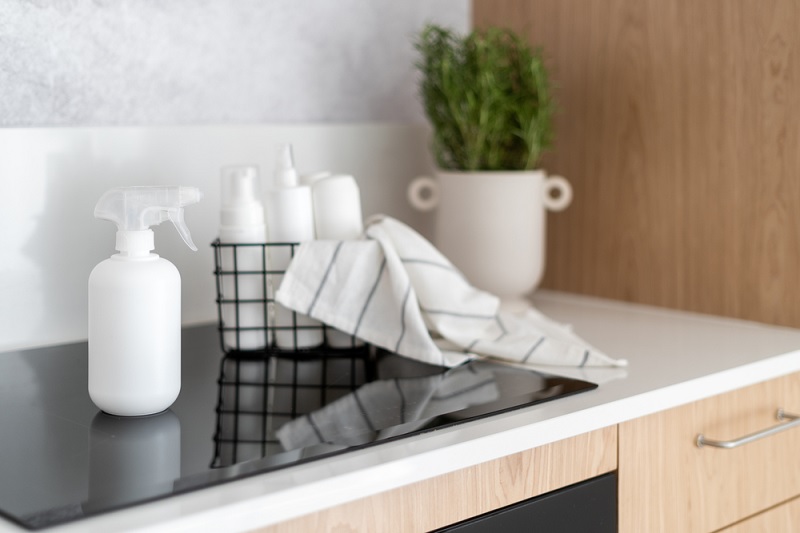
Regularly deep cleaning your induction hob can be tedious, but it is essential to caring for the appliance. Keeping it clean greatly reduces the likelihood of it breaking, saving you the money it would cost to replace the hob every few years.
Below are some of our top tips for maintaining your induction hob between deep cleans and minimising the damage that will occur with frequent use:
- Avoid dragging your pots and pans over the surface of the hob to reduce the chances of scratches in the glass.
- Quickly wipe down the induction hob after each use to remove any food debris before it becomes burned into the surface.
- Never use abrasive cleaning tools, such as wire wool and scouring pads, as they will damage the glass surface.
- Only use scraping tools when cleaning your induction hob if they have been specifically designed for that use.
- Invest in a protective hob liner that will eliminate the risk of scuffs and scratches. This one by KitchenRaku is made of a heat-resistant mesh and can be kept in place during cooking without affecting the heat transfer process.

Hannah has a passion for cleaning. She worked her way around Australia by cleaning hostels in exchange for free accommodation and used her cleaning skills to bag a job as a chalet host for a luxury ski company in France.
